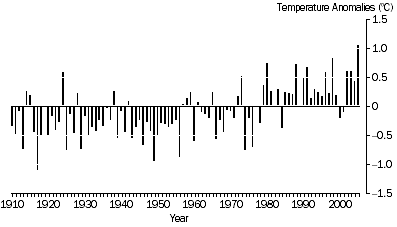CLIMATE CHANGE
ANNUAL MEAN TEMPERATURE ANOMALIES
Australia recorded its warmest year on record in 2005.
Australia's annual average (mean) temperature for 2005 was 1.09°Celsius (°C) above the standard 1961–90 average, making it the warmest year since reliable, widespread temperature observations became available in 1910. The previous record of +0.84°C was set in 1998. While these temperature departures may seem relatively small, a 1°C increase in mean temperatures is equivalent to many southern Australian towns shifting northward by about 100 km.
A record mean temperature was set because both daytime and night-time temperatures were high: the annual mean maximum temperature was 1.21°C above average (equal highest), while the mean minimum temperature was 0.97°C above average (second highest).
Temperature anomalies varied throughout the year but Autumn 2005 was particularly warm. April had the largest Australian mean monthly temperature anomaly ever recorded, with a monthly anomaly of +2.58°C breaking the previous record of +2.32°C set in June 1996.
According to meteorological records, the global average surface temperature has increased. Global temperatures in 1998, 2002 and 2003 show these were the three warmest years since 1861 – when reliable direct weather recording began. Global-average surface temperature has increased over the past 100 years by about 0.6°C. In Australia annual mean temperatures have increased, although this has not been uniform.
Many of Australia’s warmest years on record (such as 1988, 1998 and 2002) had temperatures boosted by significant El Niño events. However, no such event occurred in 2005, making the record warmth even more unusual. Since 1979, all but four years have been warmer than average in Australia.
Australian temperatures have increased by approximately 0.9ºC since 1910, consistent with global warming trends. Scientific studies have linked global and Australian temperature increases to the enhanced greenhouse effect. While this warming trend is expected to continue into the decades ahead, annual temperatures are influenced by numerous factors, including natural variability, so 2006 will not necessarily be warmer than 2005.
ANNUAL MEAN TEMPERATURE ANOMALIES
 Note: Departures from 1961–90.
Source: Bureau of Meteorology http://www.bom.gov.au, last viewed 16 June 2006.
Note: Departures from 1961–90.
Source: Bureau of Meteorology http://www.bom.gov.au, last viewed 16 June 2006.
ANNUAL RAINFALL
In addition to being warm, the early months of 2005 were also very dry over much of Australia. The January-May period was the second driest on record. From June onwards rainfall reverted to near- to above-normal levels over much of Australia, but the lack of sustained above-normal rainfall led to the continuation of multi-year droughts in parts of Australia, particularly in the southeast.
Preliminary data indicate that the average total rainfall throughout Australia for 2005 was about 399 millimetres (mm), compared with a long-term average of 472 mm. Most regions recorded slightly-below or near-normal rainfall for the year.
In many parts of Australia, the 2002–03 drought was followed by a series of relatively dry years. This made the effects of the drought worse. The recent drought may be unusual in that it was also warmer than previous droughts in the last 50 years.
 Print Page
Print Page
 Print All
Print All